Cable knitting needles are indispensable tools for knitters seeking to add intricate texture and dimension to their projects.
These specialized needles are designed for the art of cable knitting, a technique that creates eye-catching patterns by crossing stitches over one another.
Typically short and stubby, cable needles come in various materials and sizes to complement your knitting needles.
Their primary purpose is to hold a small number of stitches temporarily, allowing you to manipulate and rearrange them to form beautiful cable designs.
Understanding cable needles and mastering their use opens up a world of creative possibilities, enabling knitters to craft stunning, visually captivating garments and accessories.
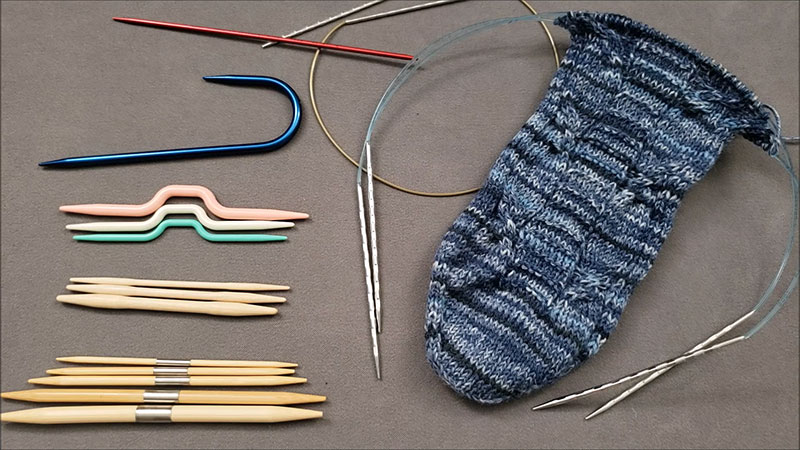
What Are Cable Knitting Needles?
Cable knitting needles, also known as cable needles, are specialized knitting tools used in the art of knitting to create intricate cable stitch patterns.
These needles are not used for all knitting projects but are essential when you want to add texture and dimension to your knitted fabric by crossing stitches over one another.
Here’s how cable knitting needles work and what they look like:
Shape
Cable needles are typically short and stubby, often resembling a small double-pointed needle or a U-shape.
They are designed to hold a small number of stitches temporarily while you manipulate other stitches.
Purpose
Cable needles are used to hold stitches in front or behind the work, allowing you to cross them over each other to create cable patterns.
Cable patterns are made by knitting stitches out of order, which is why you need to temporarily move some stitches aside while you work on others.
Usage
To use a cable needle, you slide a few stitches onto the cable needle from your main knitting needle.
You then either hold the cable needle in front or behind your work as directed by the pattern. You knit the next few stitches from the main needle, and then you knit the stitches from the cable needle.
Variety
Cable needles come in various materials, including plastic, metal, wood, and bamboo. They can also vary in size, so you should choose a cable needle that matches the size of your knitting needles for a consistent gauge.
Types
There are different types of cable needles available, such as straight cable needles and U-shaped cable needles.
The choice of which one to use depends on your personal preference and the specific cable pattern you are working on.
What Does a Cable Needle Look Like?
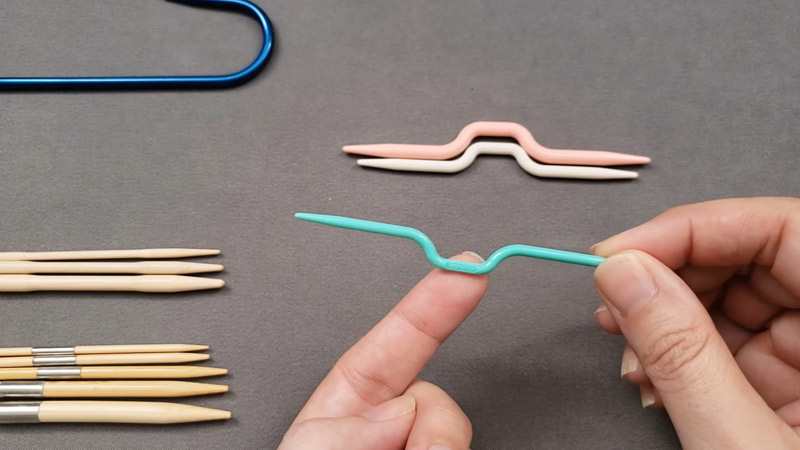
A cable needle is a small, often U-shaped or hook-shaped tool used in knitting and sometimes in crochet to help manipulate stitches when creating cable patterns.
Its primary purpose is to hold a few stitches temporarily while you work other stitches from your knitting needles.
This technique creates twists and crosses in the stitches, forming the characteristic cable patterns seen in knitwear.
Here is a description of what a cable needle typically looks like:
Size
Cable needles come in various sizes, but they are usually quite small, typically around 3 to 5 inches (7.5 to 12.5 cm) in length.
Shape
There are a few different shapes for cable needles:
- Straight Needle: This type looks like a small double-pointed knitting needle with a small, often tapered point at each end. It resembles a short, straight stick.
- U-shaped Needle: This type forms a U-shape, with a bend in the middle. It can be open-ended or have small knobs or stoppers on the ends to prevent stitches from slipping off.
- Hooked Needle: Some cable needles have a hook at one end to make it easier to catch and hold the stitches.
Material
Cable needles can be made from various materials, including plastic, metal, wood, and bamboo. The choice of material often comes down to personal preference.
Size Markings
Some cable needles may have size markings on them to help you identify their size, especially if you have multiple cable needles of different sizes.
Types of Knitting Needles
Knitting needles come in various types, materials, and sizes, each suited for specific knitting techniques and preferences. Here are some common types of knitting needles:
Single-Pointed Needles
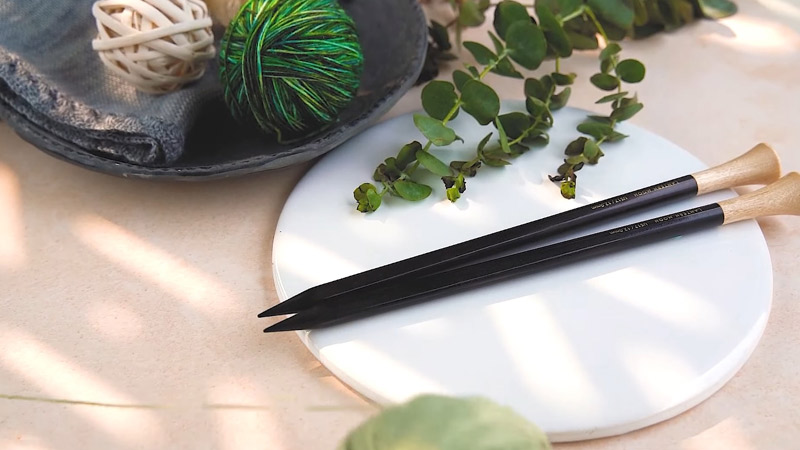
These are the most traditional knitting needles, with a point at one end and a knob or stopper at the other end.
They are used for flat knitting, where you work back and forth in rows. They are available in various materials, including wood, bamboo, plastic, and metal.
Double-Pointed Needles (DPNs)
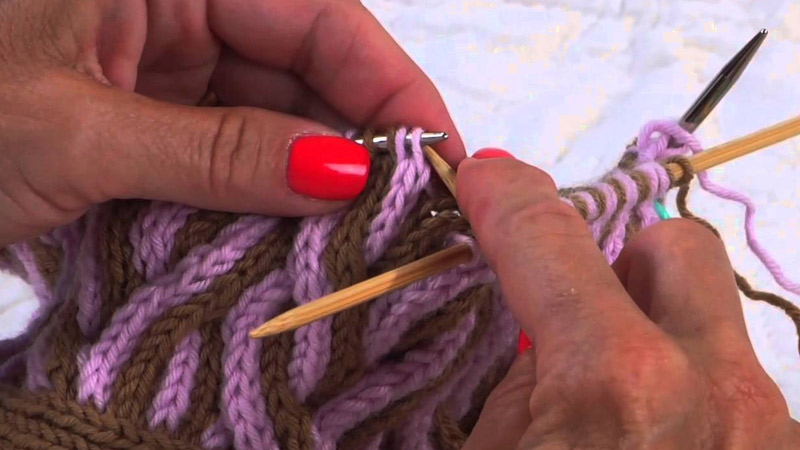
DPNs are pointed needles on both ends, typically used for knitting in the round. They’re commonly used for knitting smaller items like socks, mittens, and sleeves. DPNs come in sets of four or five.
Circular Needles
These consist of two pointed needles connected by a flexible cable. Circular needles are versatile and can be used for both flat and circular knitting. They are excellent for larger projects like sweaters and blankets.
Interchangeable Needles
These sets include multiple needle tips and cables that can be combined to create various needle lengths and sizes. They offer flexibility and versatility, making them suitable for a wide range of projects.
Fixed Circular Needles
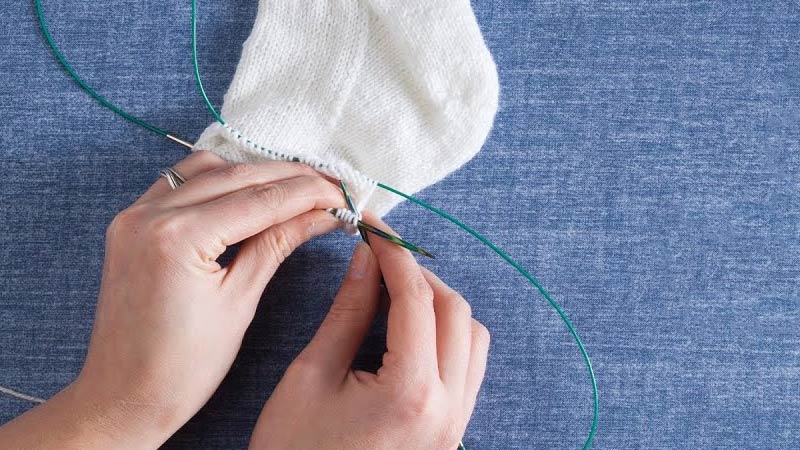
These are circular needles with fixed needle tips. They are available in various lengths and sizes, ideal for projects that require specific dimensions.
Lace Needles
Lace knitting needles have sharp and slender tips, making them perfect for intricate lacework. They allow you to work with delicate yarns and intricate stitch patterns.
Chunky Needles
Chunky or bulky needles are thicker and designed for use with heavier-weight yarns, creating larger, warmer items like scarves and blankets more quickly.
Specialty Needles
There are specialty needles for specific techniques, such as cable needles (for creating cable patterns), Tunisian crochet hooks (for Tunisian crochet), and double-ended needles (for techniques like tubular knitting or i-cord).
Bamboo and Wood Needles
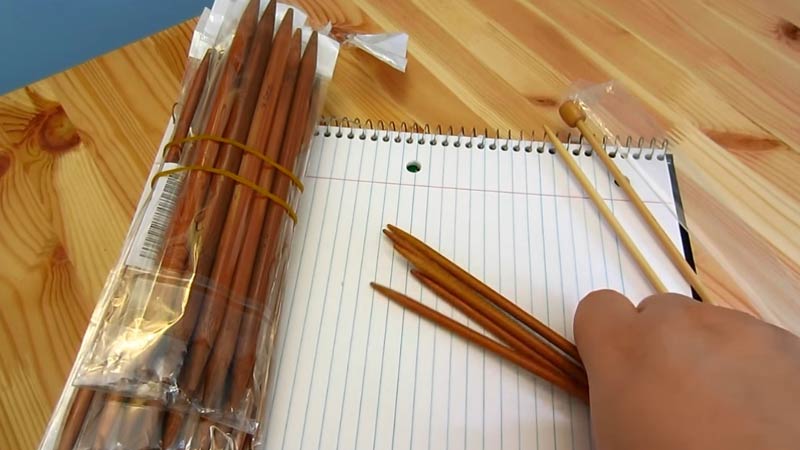
These needles are favored for their warmth, lightweight feel, and flexibility. They are often chosen for their tactile qualities and are less slippery, making them suitable for beginners.
Metal Needles
Metal needles are known for their smoothness and slickness, making them excellent for fast knitting. They are a popular choice for experienced knitters.
Plastic Needles
Plastic needles are lightweight and affordable, making them a suitable choice for beginners. They are less slippery than metal needles and quieter during knitting.
Carbon Fiber Needles
These needles are lightweight, strong, and known for their durability. They have a slightly grippy surface, which can be helpful when working with slippery yarn.
How to Use Cable Knitting Needles?

Cable knitting needles, also known as cable needles or cable stitch holders, are tools used in knitting to create decorative and textured patterns, such as cables and twists.
These needles are typically short and have a U or J shape with a knob or stopper at one or both ends to prevent stitches from sliding off.
Here’s how to use cable knitting needles to create cable stitches:
Materials Needed:
- Yarn
- Knitting needles (main needles)
- Cable knitting needle
- Knitting pattern with cable instructions
Steps:
Set-Up
Begin by casting on the required number of stitches for your project using your main knitting needles. These stitches are the ones you’ll use to create the cable pattern.
Identify the Cable Stitch
Refer to your knitting pattern to identify where the cable stitches are located. The pattern will specify how many stitches to use for the cable and which direction to move them.
Prepare to Work the Cable
When you reach the point in your pattern where a cable is instructed, you’ll need to work with a subset of stitches from your main needle.
For example, if your pattern says “C4B” (Cable 4 Back), you’ll work with four stitches for the cable.
Transfer Stitches to the Cable Needle
Slip the number of stitches required for the cable onto the cable needle. If the pattern says “C4B,” you’ll slip four stitches onto the cable needle.
Hold the Cable Needle
Hold the cable needle in your non-dominant hand, either with the knob or stopper facing upward. This needle will temporarily hold your cable stitches out of the way.
Continue Knitting
After transferring the stitches to the cable needle, let it hang in front or behind your work, depending on the cable direction specified in your pattern. Work the next set of stitches on your main needle as instructed in the pattern.
Knit from the Cable Needle
Once you’ve worked the stitches on your main needle, bring the cable needle with the held stitches into position.
Use your main knitting needle to knit the stitches directly from the cable needle. If the pattern specifies “C4B,” you’ll knit the four stitches from the back of the cable needle.
Complete the Cable
After knitting the stitches from the cable needle, you’ve created the cable twist. Continue with the remaining stitches on your main needle as per the pattern.
Repeat as Needed
If your pattern has multiple cable twists, repeat the above steps for each cable as instructed.
Finishing
As you continue knitting, your cable stitches will be integrated into your project, creating the cable pattern as specified in your pattern.
What Are Cable Knitting Needles Used For?
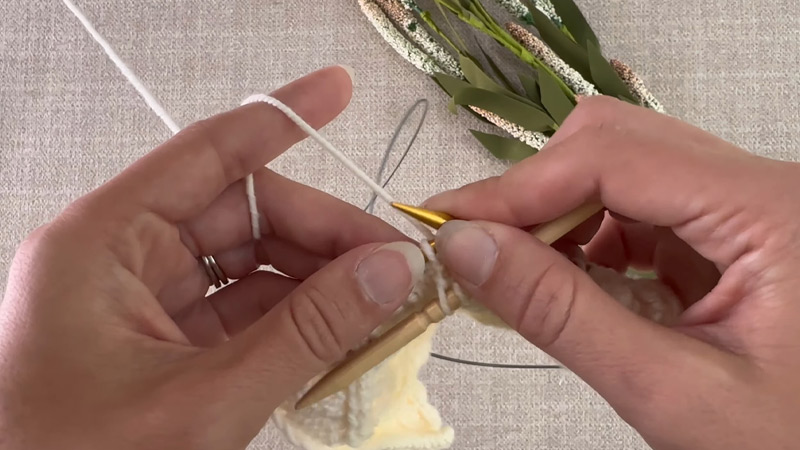
Cable knitting needles, also known as cable needles, are used for a specific knitting technique called cable knitting.
Cable knitting is employed to create intricate textured patterns in knitted fabric, often resembling twisted ropes or braids.
Here’s what cable knitting needles are used for:
Creating Cable Patterns
The primary purpose of cable knitting needles is to create cable stitch patterns in knitting. These patterns involve crossing a certain number of stitches over one another to form twists, braids, or other decorative designs.
Manipulating Stitches
Cable needles are essential for temporarily holding a small group of stitches aside while you work on other stitches in a specific order. This allows you to cross stitches over each other to achieve the desired cable pattern.
Adding Texture and Interest
Cable knitting adds visual interest and depth to knitted garments and accessories. It’s a way to break up the monotony of plain stockinette or garter stitch and create eye-catching motifs and designs.
Enhancing Creativity
Cable knitting needles open up a world of creative possibilities for knitters. By learning how to use cable needles effectively, knitters can experiment with various cable designs and incorporate them into sweaters, scarves, blankets, and more.
Advantages of Using Cable Knitting Needles
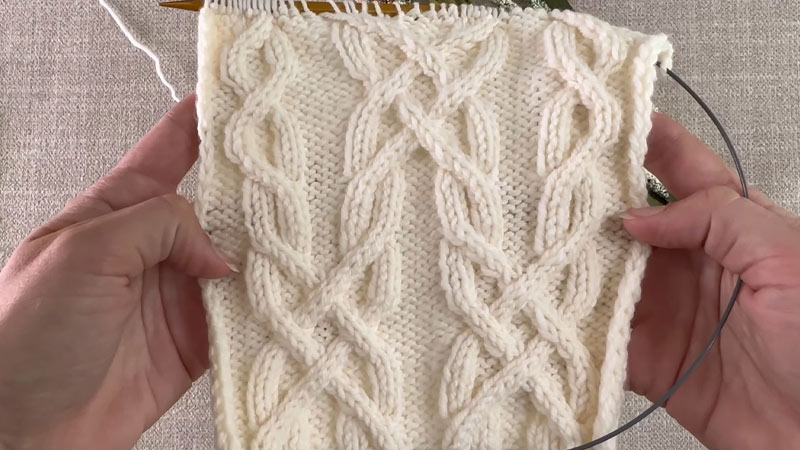
Cable knitting needles, also known as cable needles, are specialized tools used in knitting to create intricate cable stitch patterns.
These needles have several advantages that make them essential for cable knitting:
Cable Control
The primary purpose of cable needles is to hold a portion of stitches aside while you work on another set of stitches, creating the characteristic twist or crossing effect in cable knitting. This control ensures that your cable stitches are neat and well-defined.
Stitch Safety
Cable needles prevent stitches from slipping off while you’re working on other parts of your project. This reduces the risk of dropped stitches, which can be frustrating to fix in complex cable patterns.
Versatility
Cable needles come in various shapes and sizes, including straight, U-shaped, or double-ended designs. This variety allows you to choose the type of cable needle that works best for your project and personal preferences.
Enhanced Creativity
Cable knitting needles enable you to experiment with various cable stitch patterns, allowing you to create beautiful textures and designs in your knitting projects. This versatility adds a creative element to your knitting.
Improved Consistency
Using cable needles helps you maintain consistent tension and stitch size across your cable sections, ensuring that your finished project looks polished and professional.
Reduced Stress
Cable needles make it easier to tackle complex cable patterns with multiple crosses and twists. With a cable needle, you can focus on one step at a time, reducing the stress and complexity of the process.
Helpful for Beginners
Cable knitting can be intimidating for beginners, but cable needles provide additional support and control. They help new knitters gain confidence and develop their cable knitting skills.
Portable and Lightweight
Cable needles are usually small and lightweight, making them easy to carry in your knitting bag. This portability allows you to work on cable projects wherever you go.
Durable Materials
Cable needles are often made from durable materials like wood, plastic, or metal, ensuring they last for a long time and can withstand the rigors of knitting.
Precision
Cable needles come in various sizes, allowing you to choose the right one for your yarn and project. This precision ensures that your cable stitches are proportionate and visually appealing.
FAQS
What Is a Cable Needle?
A cable needle is a small knitting accessory used to create intricate cable patterns.
Can I use regular knitting needles for cable knitting?
Won;t work, cable needles are specifically designed to make the process smoother and more efficient. Their unique shape and purpose make crossing stitches easier and more precise.
Are cable knitting needles only for experienced knitters?
Cable knitting needles can be used by both beginners and experienced knitters.
Can I make my own cable needle?
Yes, you can fashion a makeshift cable needle from a spare DPN (double-pointed needle) or a small straight knitting needle.
Do cable needles come in different shapes?
Yes, cable needles come in various shapes, including straight, U-shaped, and even some with a bend.
What should I do if I lose my cable needle mid-project?
If you misplace your cable needle, you can use a removable stitch marker or even a spare piece of yarn to temporarily hold the stitches while you work on the crossed cables.
Last Words
Cable knitting needles are indispensable tools for any knitter aspiring to add depth and texture to their creations.
These purpose-built needles facilitate the art of cable knitting, allowing the manipulation of stitches to craft intricate, visually captivating patterns.
Whether you’re a novice or an experienced knitter, cable needles are accessible and adaptable tools that enhance your knitting repertoire.
They come in various shapes and sizes, catering to individual preferences and the requirements of different cable designs.
While makeshift alternatives can be used, dedicated cable needles offer greater precision and convenience.
In the hands of a skilled knitter, cable needles unlock a world of creativity, enabling the crafting of beautiful, eye-catching garments and accessories.
Leave a Reply